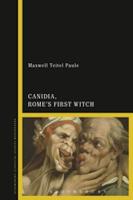
Bloomsbury Academic (2017) h/b 218pp £84.99 (ISBN 9781350003880)
What leaps from the pages of P.’s book is a compellingly colourful (if disquieting) character. In Horace’s Satire 1.8 (Chapter 2), bare-foot shrieking Canidia rips apart a lamb with her teeth, and is cast out of the Garden of Maecenas by a farting statue of the ithyphallic Priapus. In Epode 5 (Chapter 3) the witch, her unkempt hair bound with snakes, buries a child up to his chin to be starved to death in sight of a meal renewed three times a day, so she can harvest his dried liver and bone marrow for a love potion. In Epode 7 (Chapter 4), she has an encounter with the poet himself, keeping Horace alive just so she can torture him.
This is the first book dedicated to Canidia—and the undivided attention is not undeserved. Against the claim of the scholiasts (and many modern scholars), that ‘Canidia’ was really Gratidia, a Neapolitan perfume seller who dumped Horace, P. argues that Canidia is best treated as a fictional character (2-6). This is a refreshing approach, given the fundamental fallacy of biographical reconstruction in literary analysis: even when poets choose to include factually accurate autobiography in their work they do so because it makes poetic sense, so the presumed existence of one Gratidia can never fully explain Horace’s depiction of Canidia. An appeal to (supposed) biographical reality cannot, in other words, provide a substitute for convincing literary interpretation. And P.’s interpretation is a convincing one. Whereas much recent scholarship has defined Roman witches as an unchanging character type, P. offers a nuanced examination of a persona whose attributes fluctuate depending on the contexts in which they are mobilised. P. notes that Latin has myriad terms for ‘witch’, which nebulous vocabulary in turn means that ‘each witch is, in essence, a blank canvas onto which a myriad of traits may be projected to reflect one’s fears and anxieties’ (8).
In this book, P. focuses on Canidia’s function in the three poems mentioned above. A composite picture emerges: from Chapter 2, a metanarrative in which Canidia acts as a tool Horace uses to comment on his literary process; from Chapter 3, a response to the Roman civil wars and expectations of coming peace; from Chapter 4, a further metapoetic statement, this time on Horace’s separation from the genre of iambus. The widening out of the analysis in Chapter 5 to passing references to Canidia in Epode 3 and Satire 2.1 and 2.8 delivers the final blow: this multifaceted character cannot be confined to a single type, but is deployed wherever and however the poet needs her. The discussions of individual poems are unfailingly rich. I would draw particular attention to the ambitious Chapter 3, which offers a comparative study of child-killing demons (Near-Eastern Lilith, the Roman strix, and Greek Lamia), alongside a complex intertextual investigation that traces the relationship between Epode 5 and Epode 16 and posits that both were intended to function as a paired response to Virgil’s Eclogue 4.
Interesting studies on ancient witchcraft and the figure of the witch have been published in recent years, of particular note being another Bloomsbury volume Ancient Magic and the Supernatural in the Modern Visual and Performing Arts, edited by Filippo Carlà and Irene Berti (2015, reviewed on this site). P.’s book provides the perfect complement to such broad-ranging diachronic surveys, focusing in on one witch, one poetic corpus, and engaging in close reading. The reader can engage along with him: with the full text and translation of the main poems under discussion provided at the beginning of their chapters, this book is accessible also to the uninitiated.
Dr Lilah Grace Canevaro—The University of Edinburgh
